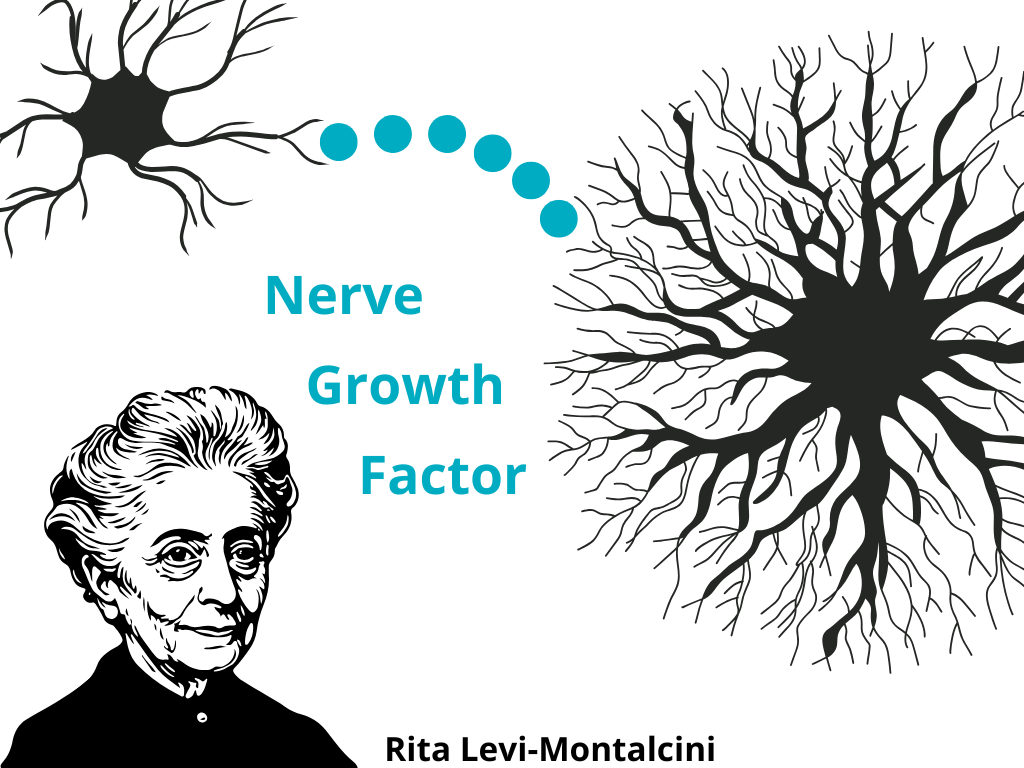The Mother of NGF:
Rita Levi-Montalcini
When we think about the nerve growth factor (NGF), one name immediately comes to mind: Rita Levi-Montalcini. And when we think of her, we inevitably think of NGF. While she was not the only scientist responsible for its discovery, NGF became her “scientific child”— a discovery she nurtured, developed, and carried with her throughout a long life devoted to science.
Rita Levi-Montalcini was born in Turin in 1909. After earning her medical degree, she specialized in neurology and psychiatry in 1936. However, her promising career was abruptly interrupted by Italy’s racial laws of 1938. As a Jewish woman, she was expelled from academic life. She moved to Belgium for a time, working in a neurological institute in Brussels, but the war soon forced her back to Turin. There, in a bedroom of her family’s home, she created a makeshift laboratory. With simple tools , she studied chick embryos and began exploring how the nervous system develops, inspired by the work of Viktor Hamburger.
In 1947, Hamburger invited her to Washington University in St. Louis. What was meant to be a short fellowship turned into decades of collaboration. Together, they studied how developing neurons depend on signals from their targets to survive — a radical idea at the time, since most believed neuronal development was independent and autonomous. TRita Levi-Montalcini showed that without signals from their targets, neurons die. This insight would become the foundation of her greatest discovery.
By implanting fragments of mouse tumors into chick embryos, she observed that nerve fibers grew abundantly toward the tumor tissue. The effect was so striking that she suspected the tumor released a diffusible substance that attracted and stimulated nerves. Working with Stanley Cohen, a biochemist at Washington University, she went further and together they isolated and characterized this mysterious molecule. It was a protein and they named it Nerve Growth Factor.
Over time, Levi-Montalcini and her colleagues realized that NGF’s influence extended beyond the nervous system, affecting other cells such as those of the immune system. This helped establish the broader concept of growth factors as key regulators of life processes — and revealed how their misregulation can lead to disease. In fact, today we now know that growth factors are implied in several cellular functions such as survival, proliferation, differentiation (just to cite some). As a consequence, we know that, for example, changes in growth factor pathways can drive cancer while insufficient trophic support can contribute to neurodegeneration. NGF was the first of many neurotrophic factors discovered, including BDNF, NT-3, and others. In animal studies, these molecules have shown the power to protect and rescue neurons, though delivering them safely and effectively to patients remains one of medicine’s great challenges.
For the discovery of NGF, Rita Levi-Montalcini and Stanley Cohen were awarded the Nobel Prize in Physiology or Medicine in 1986. She lived to the remarkable age of 103, maintaining her sharp mind (see one of her interviews at age 100: Video) and passed away in 2012. She never married or had children, dedicating her entire life to research and teaching.
From the improvised laboratory in her bedroom to the Nobel prize decades later, her story is one of perseverance and creativity. Rita Levi-Montalcini transformed hardship into discovery, and her “scientific child”, the nerve growth factor or NGF, became a gift that shaped the future of neuroscience.
📖 References:
- Luigi Aloe, Rita Levi-Montalcini: the discovery of nerve growth factor and modern neurobiology, Trends in Cell Biology, 2004.
- Armin Blesch, Neurotrophic Factors in Neurodegeneration, Brain Pathology, 2006.
- Interview Rita Levi-Montalcini, Nobel Prize in Medicine 1986, Youtube (https://www.youtube.com/watch?v=3dMQv0xcxQc)

